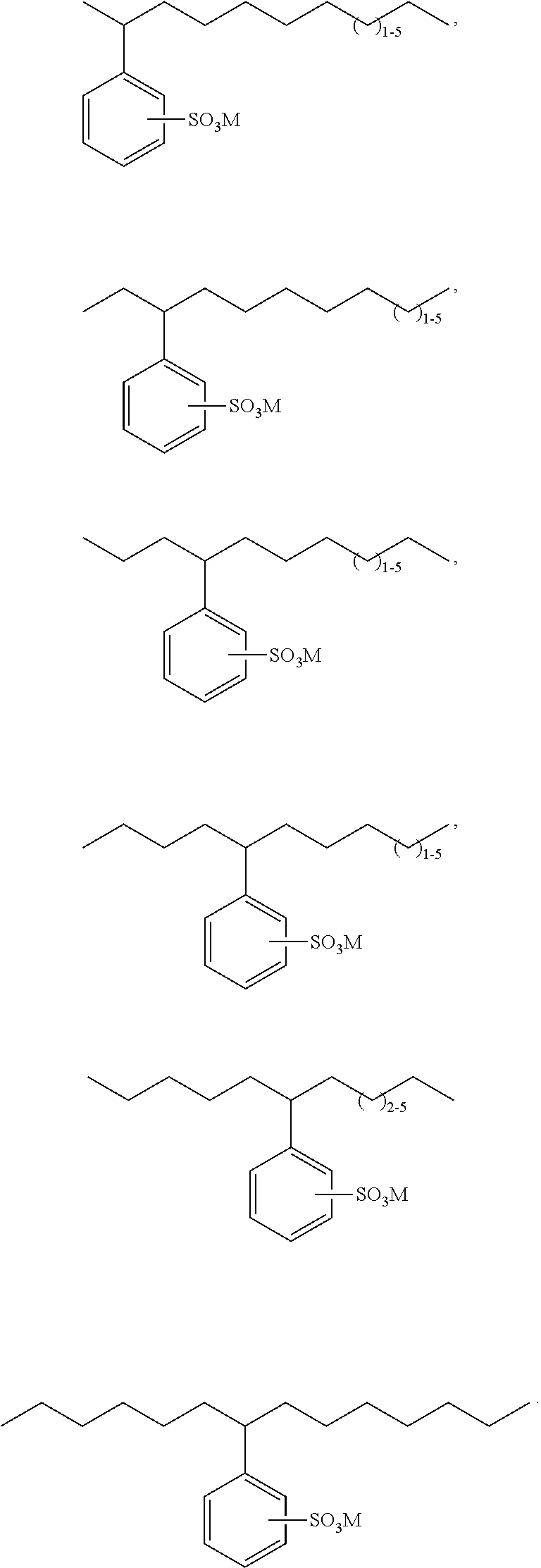Bio-based linear alkylphenyl sulfonates
a technology of alkylphenyl sulfonate and bio-based alkylphenyl sulfonate, which is applied in the direction of detergent dyes, hair cosmetics, detergent compounding agents, etc., can solve the problems of less efficient builders, less liquid products without calcium control, and less surfactant us
- Summary
- Abstract
- Description
- Claims
- Application Information
AI Technical Summary
Problems solved by technology
Method used
Image
Examples
example 1a
Synthesis of Individual Chain Length Alkenes Having at Least 50% Bio-Based Carbon Content for Blending to Standard Commercial Distributions Via Alkene Metathesis
[0288]The metathesis synthesis procedure of US2010 / 0145086A1 was followed using one of 2-butene, 3-hexene, 4-octene, or 5-decene and soybean oil to provide C11, C12, C13 or C14 alkenes, respectively, for blending. The C10 alkene needed for blending is obtained via metathesis of 1-hexene and soybean oil; the C14 alkene also formed is easily separated from the C10 by simple distillation and can also be used for blending. The following commercially representative olefin blends are prepared using the individually-produced alkenes as shown in the table below.
OlefinChainAvgAvgAvgAvgAvglength11.411.1411.611.712.210223210139.31131.933.137.230.521.01229.625.232.331.525.61316.19.719.924.330.7140.300.70.713.5
example 1a1
Synthesis of an Avg 11.7 Alkene Mixture Using Metathesis
[0289]By using the right mixture of butenes and hexenes derived from various sources one can prepare a close match to the Avg. 11.7 olefin blend listed in the table above. Thus, reaction of oleic acid with an olefin blend comprising 0.246 molar equivalents of 1-butene, 0.062 molar equivalents of 2-butene, 0.0145 molar equivalents of 1-hexene, 0.486 molar equivalents of 2-hexene, and 0.192 molar equivalents of 3-hexene in the presence of a metathesis catalyst produces an olefin mixture having the chain length distribution noted in the above table for Avg. 11.7.
Molar Equivalents Wt. % ofChain Provided by Each MixturelengthFeed OlefinProduced100.007 from 1-hexene19.60.246 from 1-butene110.243 from 2-hexene26.00.062 from 2-butene120.192 from 3-hexene29.30.123 from 1-butene130.243 from 2-hexene24.5140.007 from 1-hexene0.8
example 1b
Synthesis of a Commercial Bio-Based Linear Alkyl Benzene Mixture
[0290]The alkene mixtures from Example 1a are alkylated using any of the procedures in known in the art, such as, Alul et al., J. Org. Chem., 32(11):3365-3369 (1967) to prepare the commercial linear alkylbenzenes.
PUM
| Property | Measurement | Unit |
|---|---|---|
| wt % | aaaaa | aaaaa |
| wt. % | aaaaa | aaaaa |
| wt. % | aaaaa | aaaaa |
Abstract
Description
Claims
Application Information
 Login to View More
Login to View More - R&D
- Intellectual Property
- Life Sciences
- Materials
- Tech Scout
- Unparalleled Data Quality
- Higher Quality Content
- 60% Fewer Hallucinations
Browse by: Latest US Patents, China's latest patents, Technical Efficacy Thesaurus, Application Domain, Technology Topic, Popular Technical Reports.
© 2025 PatSnap. All rights reserved.Legal|Privacy policy|Modern Slavery Act Transparency Statement|Sitemap|About US| Contact US: help@patsnap.com



